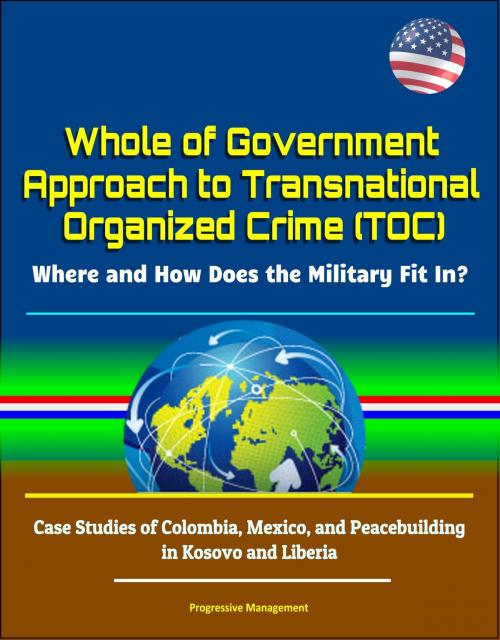Whole of Government Approach to Transnational Organized Crime (TOC): Where and How Does the Military Fit In? Case Studies of Colombia, Mexico, and Peacebuilding in Kosovo and Liberia
Nonfiction, History, Military, United States, Social & Cultural Studies, True Crime| Author: | Progressive Management | ISBN: | 9780463740545 |
| Publisher: | Progressive Management | Publication: | May 9, 2018 |
| Imprint: | Smashwords Edition | Language: | English |
| Author: | Progressive Management |
| ISBN: | 9780463740545 |
| Publisher: | Progressive Management |
| Publication: | May 9, 2018 |
| Imprint: | Smashwords Edition |
| Language: | English |
This excellent report has been professionally converted for accurate flowing-text e-book format reproduction.
Transnational crime is a recognized threat to national security, mostly due to their relation to terrorist organizations. The President has called for a Whole of Government approach to combatting the threat from Transnational Organized Crime (TOC). The Strategy written in 2011 illustrates the differences of TOCs in the different geo-political regions, however, it does not illustrate in detail the varying degrees of influence the military, and specifically the Army, will have in each of these regions, as a part of the whole of government principle. The focus of this study is on identifying the role of the Army in combatting TOC. It will identify the role of the TOC in the growth of terrorist organizations, and identify when is the best time to affect criminal organizations to protect our national interests.
CONTENTS * CHAPTER 1 INTRODUCTION * Problem Background * Problem Statement * Purpose of the Study * Research Questions * Significance * Limitations * Delimitations * Theoretical Framework * Operational Definitions * Summary * CHAPTER 2 LITERATURE REVIEW * Introduction * Transnational Organized Crime in the U.S., Europe, and Abroad * Case Study: Colombia * Case Study: Mexico * Peacebuilding and Organized Crime: The Cases of Kosovo and Liberia * Conclusion * CHAPTER 3 RESEARCH METHODOLOGY * Introduction * Data Collection * Data Analysis * Threats to Validity * Conclusion * CHAPTER 4 DATA PRESENTATION AND ANALYSIS * Introduction * Operational Environment: Current U.S Policy against TOC * Line of Operation 1: Colombia Case Study * Line of Operation 2: Mexico Case Study * Line of Operation 3: Liberia and Western Africa Case Study * Line of Operation 4: Kosovo Case Study * End State: Whole of Government Approach * Role of the Military * Conclusion * CHAPTER 5 CONCLUSIONS AND RECOMMENDATIONS * Introduction * Conclusions * Recommendations * Recommendations for Further Research * REFERENCE LIST
The concern over TOC is the convergence of criminal organizations, transnational movement, and the occasional mutual benefit they receive from alliance to terrorist organizations. This Strategy against this threat is "organized around a single unifying principle: to build, balance, and integrate the tools of American power to combat transnational organized crime and related threats to national security—and to urge our foreign partners to do the same".
Along with an emphasis on this emerging threat, the U.S. national strategy addresses these problems by using a whole of government approach. Though the military will not take the lead in this effort, the role of the military will be one of support. The problem is how the U.S. military will effectively integrate with the strategy, or whether or not the military should be involved at all in this mission. The emergence of Regionally Aligned Forces for the military also presents a challenge for inter-cooperation amongst Combatant Commanders (COCOM), as TOC by its definition works beyond the boundaries of nation-states. If the military participates in a whole-of-government approach, the regional alignment of forces must be considered. Coordination will occur at the strategic level, and areas such as logistics and intelligence will require multiple coordinated efforts in order to be effective. This is normal during many different operations; the question is whether the cost-benefit is good enough to warrant such an effort.
This excellent report has been professionally converted for accurate flowing-text e-book format reproduction.
Transnational crime is a recognized threat to national security, mostly due to their relation to terrorist organizations. The President has called for a Whole of Government approach to combatting the threat from Transnational Organized Crime (TOC). The Strategy written in 2011 illustrates the differences of TOCs in the different geo-political regions, however, it does not illustrate in detail the varying degrees of influence the military, and specifically the Army, will have in each of these regions, as a part of the whole of government principle. The focus of this study is on identifying the role of the Army in combatting TOC. It will identify the role of the TOC in the growth of terrorist organizations, and identify when is the best time to affect criminal organizations to protect our national interests.
CONTENTS * CHAPTER 1 INTRODUCTION * Problem Background * Problem Statement * Purpose of the Study * Research Questions * Significance * Limitations * Delimitations * Theoretical Framework * Operational Definitions * Summary * CHAPTER 2 LITERATURE REVIEW * Introduction * Transnational Organized Crime in the U.S., Europe, and Abroad * Case Study: Colombia * Case Study: Mexico * Peacebuilding and Organized Crime: The Cases of Kosovo and Liberia * Conclusion * CHAPTER 3 RESEARCH METHODOLOGY * Introduction * Data Collection * Data Analysis * Threats to Validity * Conclusion * CHAPTER 4 DATA PRESENTATION AND ANALYSIS * Introduction * Operational Environment: Current U.S Policy against TOC * Line of Operation 1: Colombia Case Study * Line of Operation 2: Mexico Case Study * Line of Operation 3: Liberia and Western Africa Case Study * Line of Operation 4: Kosovo Case Study * End State: Whole of Government Approach * Role of the Military * Conclusion * CHAPTER 5 CONCLUSIONS AND RECOMMENDATIONS * Introduction * Conclusions * Recommendations * Recommendations for Further Research * REFERENCE LIST
The concern over TOC is the convergence of criminal organizations, transnational movement, and the occasional mutual benefit they receive from alliance to terrorist organizations. This Strategy against this threat is "organized around a single unifying principle: to build, balance, and integrate the tools of American power to combat transnational organized crime and related threats to national security—and to urge our foreign partners to do the same".
Along with an emphasis on this emerging threat, the U.S. national strategy addresses these problems by using a whole of government approach. Though the military will not take the lead in this effort, the role of the military will be one of support. The problem is how the U.S. military will effectively integrate with the strategy, or whether or not the military should be involved at all in this mission. The emergence of Regionally Aligned Forces for the military also presents a challenge for inter-cooperation amongst Combatant Commanders (COCOM), as TOC by its definition works beyond the boundaries of nation-states. If the military participates in a whole-of-government approach, the regional alignment of forces must be considered. Coordination will occur at the strategic level, and areas such as logistics and intelligence will require multiple coordinated efforts in order to be effective. This is normal during many different operations; the question is whether the cost-benefit is good enough to warrant such an effort.















